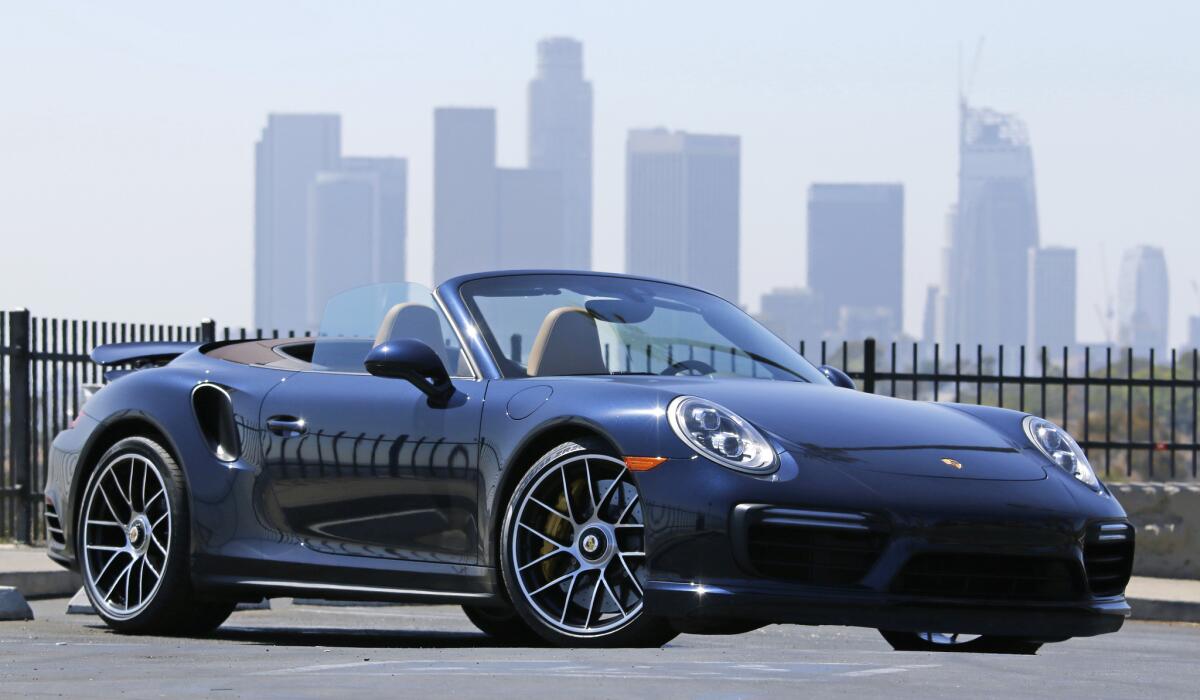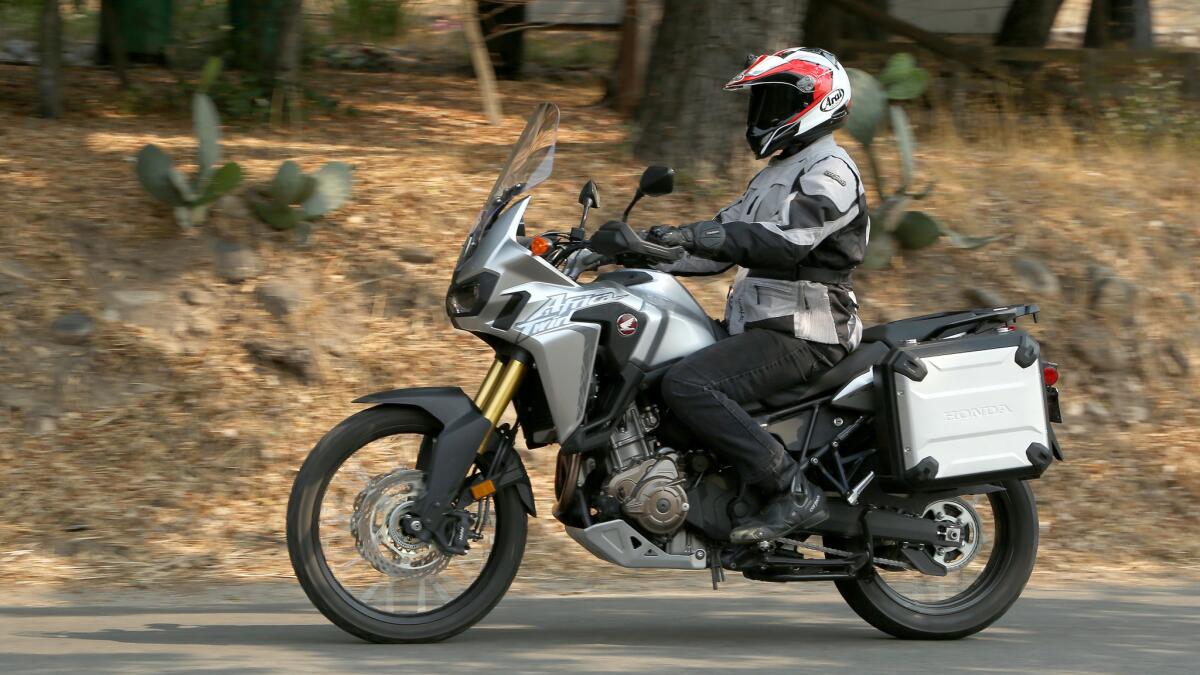Best of 2016: Highway 1’s top picks for the year

I drove, rode or reviewed almost 100 vehicles in 2016. The ones I liked best were...
Porsche’s 911 Turbo S
Equipped with a 3.8-liter, twin-turbo, 6-cylinder engine that makes 580 horsepower and 553 pound feet of torque, it’s the quickest and fastest Porsche ever built for the general public, going from zero to 60 in 2.8 seconds, up to a top speed of 205 mph — though not with me driving. But it’s smooth enough to be a daily driver and spacious enough for a weekend getaway. Down side? The $201,450 base price.
Chevrolet’s Bolt
Chevrolet’s highly anticipated long-distance and affordable Bolt EV did not disappoint. On a day-long drive from Monterey to Santa Barbara in September, I was able to squeeze 240 miles out of a single battery charge, and still had juice in reserve. More impressively, the plug-in electric sedan was easy to operate and fun to drive, and felt more like a real car than a compliance vehicle. If I were shopping for a new car, and had the $30,000 to spend -- after government incentives — I’d buy a Bolt EV.
Rolls-Royce’s Dawn
At the other end of the green energy and greenback spectrum — 14 miles to the gallon in the city, with a starting MSRP of about $400,000 — the Rolls-Royce Dawn was certainly the most elegant automobile I drove in 2016, and one of the most delicious vehicles I’ve ever piloted. Stately and silent, weighing in at almost 6,000 pounds, it is driven by a massive 6.6-liter twin-turbocharged V-12 engine that makes 563 horsepower and 575 pound feet of torque.
With the top up, it’s like driving around in a Ritz Carlton -- but quieter and with better upholstery. With the top down, it’s like driving a dirigible. I spent half a day floating around the Santa Ynez wine country, and was sorry when the drive ended.

Toyota’s Mirai
Toyota isn’t the only company offering a hydrogen fuel cell car, but its 2016 Mirai is the first vehicle featuring that technology for sale to the public. Unlike similar fuel cell cars offered by Hyundai, Mercedes-Benz and Honda, the Mirai can be leased and purchased outright.
Toyota priced the Mirai at a starting MSRP of $58,335 — some buyers will qualify for tax incentives of up to $8,000 — and offers a lease deal of $499 a month, for three years, after a $4,000 down payment. To sweeten that, Toyota will also pay for all the Mirai’s hydrogen for the first three years, up to $15,000 worth.
For that, early adopters get access to the carpool lane in a sturdy, silent sedan, powered by an electric motor that doesn’t have to be plugged in and promises a range of 312 miles per tank of hydrogen. The drawback: There are fewer than 20 fueling stations in all of Southern California, though more are under construction.

Ford’s F-150
The Ford F-150 is America’s favorite vehicle, selling more units every year, year after year, than any other. For 2016, Ford made a bold play to replace many of this workhorse’s heavy metal components with lightweight steel and aluminum, part of an effort to reduce weight and increase fuel economy.
The result, in the form of the 2016 Supercrew Limited 4x4, was a delight to drive. It felt sturdy, serene on the street and solid in the dirt, eating up the miles and smoothing out the bumps, as I tossed it around some of the local canyons.
Equipped with Ford’s standard 3.5-liter V-6 Ecoboost engine, but also available with a 5-liter V-8, and pushing a six-speed automatic transmission, it only gets an EPA estimated 18 miles per gallon for combined city and highway driving. With a current average U.S. regular gas price of barely above $2 a gallon, Ford’s going to sell a lot of these big boys.

Honda’s Civic
Honda decided to change it up, style-wise, with its 2016 Civic. Instead of targeting other domestic sedans popular in the U.S., the Japanese giant went for a more European look and feel, while still staying mainstream enough not to scare anyone into thinking it was an Alfa Romeo.
No fear. The result is a very Honda-like sedan — economical, dependable and fun to drive, but still a little dull.
The four-door, five-seat sedan gets an EPA-reported 35 miles per gallon in combined city and highway driving, off a 1.5-liter turbocharged 4-cylinder engine that zips around town and around slow traffic on the highway. Best of all, it has a base MSRP of under $20,000.

Land Rover’s Range Rover
The Range Rover series is like the rich man’s RAV-4, and they are increasingly ubiquitous on the L.A. landscape. This doesn’t make a ton of sense, because most of us here don’t drive often enough in snow, ice, mud or sand to justify the $65,000 starting MSRP for this car.
But what a car! The version we borrowed was equipped with a 3.0-liter turbo V6 diesel engine — a $1,500 option — that cranks out 254 horsepower and a whopping 443 pound-feet of torque. I was also won over by the electronics, including one of the best Adaptive Cruise Control packages I’ve ever encountered.
Despite its 4,600-pound curb weight, this Range Rover Sport cruised around town like a much smaller vehicle, and felt entirely at home in the rough stuff. Now, if I could just find a little more snow and ice to play in…

Chrysler’s Pacifica
Despite our current love affair with the SUV, American consumers buy almost half a million minivans every year. So, it wasn’t daffy counter-programming that led Chrysler to introduce the new Pacifica 7-seater in both a gasoline and plug-in hybrid version.
The gasoline version is powered by a 3.6-liter V6 engine, offering 287 horsepower and 262 pound feet of torque, mated to a nine-speed automatic transmission, and was very well behaved around town and on the freeway. Spacious, comfortable and easy to drive, it made me wish I still had young children around, asking me to drive them to soccer practice.
Well, almost. Maybe there will be an all-electric version in time for grandkids.

Honda’s Africa Twin
Man does not live on car alone — at least, not this man — and 2016 was a great year for motorcycles, too. I really liked the Indian Springfield, the Zero FX and the Ducati Multistrada. But the bike that impressed me most was Honda’s adventure bike offering, the long-awaited Africa Twin.
The AT, which is also known as the CRF1000L, is a likable, rideable machine. Well-made and well-balanced, it’s slender and rides light for a bike that weighs 511 pounds with a full tank of fuel.
With a 34-inch seat height, and an MSRP of $12,999 that doesn’t include heated grips, center stand, panniers or top box, the AT isn’t for everyone.
But a cross-shopping adventure rider will find that a new BMW GS, KTM Adventure or Ducati Multistrada Enduro costs $19,000 and up — way up, with all the options — making the AT one of the best new bike bargains of the season.







